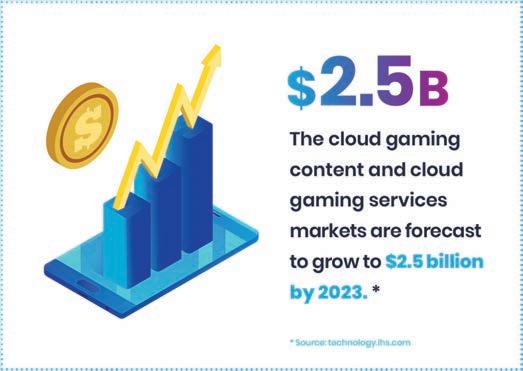
12 minute read
Industry Voices
MCV/DEVELOP gives the industry a platform for its own views in its own words. Do you have a burning hot take for the world of games? Get in touch!
Advertisement
Hannah Flynn, communications director, Failbetter Games
18 | MCV/DEVELOP February 2020 THE store page is an absolutely crucial component of your game’s marketing. All of your marketing efforts will be for nought if the store page that people land on doesn’t drive them to take an action – be it to put a game on their wishlist, follow or purchase.
I review store pages for other indies on Twitter every week, and I see the same things coming up quite often. Here are three things which I’ve seen pages miss the mark on:
Firstly, can people understand what they’re getting, based on the information on your page? Can they tell quickly what the genre of game is, what they do in it?
People are browsing for games that they know they’ll like. This isn’t the place to tease or hint at what your game does. Be as upfront as possible about what your game is offering. When developing the capsule art for Sunless Skies, we did a survey to fi nd out what impression our artwork was giving people about the game. We discarded ideas which gave the wrong impression, or which didn’t contain enough information, and ended up with a large central image of a steam train fl ying through space – which is a pretty good depiction of what you do in Sunless Skies! Next, can the information on the page give the potential player confi dence in the game? Is everything up-to-date and factually correct?
Trustworthiness is important, because you’re trying to convince someone to do something. Try not to have anything on your page that would cause doubt, and do everything you can to build trust.
If it’s November 2019, and this game’s page says ‘coming 2019’ but doesn’t have a release date, or recent development updates, what does that say? What would make you want to follow a game which didn’t look like it was still being developed?
Sometimes on the pages I review, one part of the page disagrees with another. The description says the game has full controller support, but only the partial controller support box has been ticked. Things change throughout development; refl ect them on your page.
The most obvious mark of trustworthiness is your review score. If your review averages aren’t looking good, you should have something on your page which shows that you’re addressing it. Maybe that’s responding to reviews which are factually incorrect, or maybe it’s an announcement post about an upcoming patch. Lastly, when you have the above in place, is the page really specifi c to your game, using imagery and tone of voice that convey the feel of it well? Can you use the game’s tone of voice, or insert a few gameplay GIFs which show its atmosphere?
Also: this is not a once and done thing. Your store page is your game’s home. Every day, players are looking at it to decide if they want to try your game. Set a reminder to look at it at least monthly, and keep a rolling list of changes you want to make to keep it polished and working hard!
Hannah Flynn is a multi-award-winning marketing and community professional who has worked with Failbetter Games since 2014, launching and promoting all of their titles, including 2019’s Sunless Skies. Follow her on Twitter @itshannahfl ynn.

How To Produce a triple-A game – a valuesdriven Agile approach
Steve Cuss, head of studio operations, Criterion
MAKING any game is hard and the challenge is only becoming more and more complex. At Criterion, our approach to producing triple-A games has to accommodate scale in people, process and technology.
Planning a whole creative project from start to fi nish is an exercise in self-delusion, but not planning at all means that you never know how much farther you need to go, the direction in which you need to head or exactly what you might need. You can’t plan what you don’t know, but you need a plan.
Our approach at Criterion to be able to meet that challenge is fi rmly grounded in both our people and process philosophies. Perhaps the most impactful expression of these philosophies is in maximising autonomy – over team, task and technique – as well as adopting a leadership approach that prioritises both infl uence and inspiration.
For this to be effective, it is essential that we work hard at maintaining alignment on multiple levels, and to keep sharing context deep into our teams. This enables highly informed decisions to be made as close to the point of execution as possible.
Our approach builds upon Agile (Scrum) and Scaled Agile Framework (SAFe). However, off-the-shelf, these do not facilitate the breadth of creative and scientifi c collaboration needed to make a game. Equally we believe a full implementation of SAFe would suffocate a game team. So, we have adapted the roles and essential rituals of SAFe to work within the context of a AAA game. For example, our approach distinguishes between game direction (inspiration and direction), product management (defi nition of the game we are making) and project management (priority & sequencing). On our game team the Agile product owner role is delivered by a combination of a producer, an area lead and a development director.
Our product management takes the SAFe structure of sagas, that defi ne the boundaries of a pillar that benefi ts the game; themes, that defi ne the boundaries of the many pieces that make up each saga; and epics that describe the detail of each theme and feed our project management process.
To maximise autonomy and alignment it is important to us that the game is described at each of these levels in terms of benefi ts to the player and not instructions of what and how part of the game should be built.
We are always learning and evolving our process. We believe our approach has been one of the things that has contributed to our winning the gamesindustry.biz award for Best Place to Work, every year since their creation.
Steve Cuss started in the games industry in 1994 as a programmer. He joined Electronic Arts in 2001 and moved to Criterion in 2003, working on Black, both Burnout and Need For Speed series, Star Wars Battlefront and Battlefi eld V: Firestorm. He became Head Of Studio Operations in the summer of 2018 and that year was a Nominee for UK’s Best Boss in the gamesindustry.biz annual awards.

Is it boom or bust for chat app gaming?
SENSOR Tower data shows that in 2019, the most downloaded app in the world was WhatsApp, with approximately 850m installs. The No.3 app was Facebook Messenger – followed by Facebook itself in fourth – while Snapchat was ranked No.10 with a bit over 275m downloads.
Facebook claims its Messenger platform has 1.3bn monthly active users, while Snapchat boasts 210m daily active users.
Other huge platforms such as TikTok, which racked up close to 739m downloads in 2019, offer the ability to message friends – owner ByteDance is currently investing into games – while Discord is another large chat service that works cross-platform, generating 64m downloads on mobile last year.
The sheer number of users and level of engagement on these platforms is hard to reach anywhere else, and in theory, it holds a lot of opportunity for games.
FACING A CHALLENGE The current key players in the Western market for chat app gaming are Facebook Instant Games and Snap Games. Discord had initially moved into becoming a distribution platform for PC games, but has since stepped back on those plans.
First launched in 2016, Instant Games later allowed developers to monetise through in-app purchases and advertising. But in the face of powerful platform holders including Apple and Google, even a tech giant like Facebook faced some difficulty in taking a revenue share, given it was releasing its own games platform within apps served by other storefronts.
It was not allowed to utilise IAPs on iOS, while it also reduced its share on Google Play to zero after initially trying to take a cut on top of Google’s, which resulted in developers getting a minority split of the revenue.
Last year, Facebook made the decision to pull Instant Games from Messenger and migrated it to the social network itself. The company said at the time it wanted to make its app “faster, lighter, and simpler.” Messenger users can still be directed to Instant Games, but they are sent to Facebook.
SNAPPED UP Another contender in the chat app gaming space is Snapchat, following the launch of Snap Games in 2019 [See page 22 for more on that]. The new platform launched with titles from a few big mobile companies such as Zynga and ZeptoLab.
Snap has also shown some commitment to its ambitions in this space with the acquisitions of developer Prettygreat and London tech firm PlayCanvas. The company likely sees games as a way to increase monetisation of its platform, as well as engagement.
While just a few years ago it looked like chat app gaming was about to explode onto the scene, progress has been much slower in terms of their popularity and ability to generate revenue at the levels seen on the App Store and Google Play. If this business was significant – you’d hear about it.
There’s still promise in the idea of chat app gaming, but there are proven difficulties of working around the two major platform holders and convincing users to play games in these apps, as opposed to the other easily accessible apps on their phones.
Craig Chapple is mobile insights strategist, EMEA at mobile intelligence firm Sensor Tower and was senior editor at PocketGamer.biz.
If the future of games is streaming, developers need to ask some serious questions
Sijo Jose of PTW discusses the future of cloud streaming platforms, and the associated challenges for developers
Above: Sijo Jose, PTW president for North America & India
DESPITE early teething issues, heavy investment from the industry’s biggest players suggests cloud streaming platforms are, ultimately, where games will land in the future. Just take a look at the huge investments from Google, Microsoft, Sony, and Amazon. These tech giants don’t usually go this hard after a new platform or technology unless they see a future in it. It’s a promising sign. And if the future of games really is streaming, it signals some serious changes on the horizon for game developers and some serious questions that need to be answered rst.
How will game development standards shift? With new technology, development standards will undoubtedly shift. Now, most of these changes are likely to make life easier for developers.
One of the most notable changes will be instead of developing a game for separate hardware, like consoles, and phones, etc., development will likely be for a similar set of cloud standards – each cloud platform’s server – and the platform will handle the device speci cs.
What’s more, the simpli ed nature of streaming platforms trickles down to the rest of the development process. Take compatibility testing, for example, which has traditionally required developers to test their games on a plethora of different devices, each with different speci cations. Because all the processing happens in the cloud on these new streaming platforms, rather than on the device, developers don’t need to create specialized systems to make a game compatible on each different piece of

hardware anymore. Instead, it’s simply a matter of testing to make sure the game ts on every screen and with each controller type. So, though there will still be a need for some compatibility testing, there’ll be a signi cant reduction in developers’ efforts.
Precisely what a lot of these new development standards will look like is still up in the air but as adoption spikes and more games join these platforms, developers will need to watch closely.
How will teams change operationally to t new content demands? As monetization moves away from being hits-driven and towards long-tail subscription services, it has shifted the development lifecycle of a game. Rather than creating a game, nding and addressing bugs, launching, then leaving it to live out the rest of its time, games have become living things that demand new content updates that keep players engaged. It’s what these platforms, being subscriptionbased, will prioritize. Games like Fortnite and League of Legends have already pioneered how teams can manage continuous content delivery, but many more developers will need to start thinking about how their games will continue to live after release, too. Not only will studios need to maintain an ops team that can x bugs in the existing game, but they will also need to establish teams that are continually building, testing, and localizing new content updates at pace and scale to keep up with growing content demands.
Who will control player data? Games collect huge amounts of consumer data – time played, player preferences, churn rate, etc. And there’s a huge advantage to understanding what captures players’ attention and what turns them off.
As games move into cloud platform servers, developers risk ceding access to their own players’ data in the process. It’s not clear who will maintain access to gamers’ data yet, but one thing is clear: whoever controls this data will have greater insights into what’s working, what’s not, what players really want, and more leverage in negotiations.
No matter how the future plays out, it’s clear that cloud gaming platforms are here to stay and they will change the way games will be played and built. And helping developers gure out the path forward is what we’re all about at PTW. So, if you want to know more about how streaming and subscriptions are going to change the games industry, you can read a whole eBook about it at FutureofQA.com










